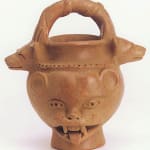Terracotta Vessel in the Form of a Jaguar's Head, 100 BCE - 500 CE
Terracotta
10
PF.4495
The ceramic artists of Costa Rica had a lively passion for creating objects with fantastic animal shapes. Monkeys, birds, lizards and jaguars were favorite subjects; not only because they were...
The ceramic artists of Costa Rica had a lively passion for creating objects with fantastic animal shapes. Monkeys, birds, lizards and jaguars were favorite subjects; not only because they were plentiful in the rain forests, but also because these animals were symbolic of various deities, which were worshiped, respected and feared. Within the context of a utilitarian object, this vessel has been transformed through imagination into something more like a reliquary of pagan myth and magic. The frontal face shows a jaguar or ocelot with its sharp teeth exposed and its tongue sticking out. Its eyes are done in such a way they seem to penetrate with shining intensity, as would a jaguar's in the night. The two heads at the ends of the handle are more serene, as if the same animal is seen during daytime, relaxed after a good meal. The artist paid close attention to detail and overall symmetry in applying a string of holes around the rim, like a necklace, which balances the small circles on the jaguar's lip representing whiskers. Further dimension and movement is added in the thick bands twisting around the handle. It is very likely this vessel was part of funerary objects of a wealthy person or nobleman who wished to carry with him something extraordinary and powerful into the other life. For this an artist of considerable skill was required to give a very earthy object an unearthly quality.



